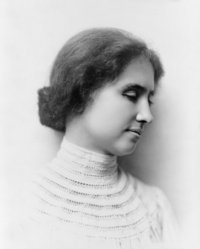Helen Keller

Helen Keller would not be bound by conditions. Rendered deaf and blind at 19 months by scarlet fever, she learned to read (in several languages) and even speak, eventually graduating with honors from Radcliffe College in 1904, where as a student she wrote The Story of My Life. That she accomplished all of this in an age when few women attended college and the disabled were often relegated to the background, spoken of only in hushed tones, is remarkable. But Keller's many other achievements are impressive by any standard: she authored 13 books, wrote countless articles, and devoted her life to social reform. An active and effective suffragist, pacifist, and socialist (the latter association earned her an FBI file), she lectured on behalf of disabled people everywhere. She also helped start several foundations that continue to improve the lives of the deaf and blind around the world.
As a young girl Keller was obstinate, prone to fits of violence, and seething with rage at her inability to express herself. But at the age of 7 this wild child was transformed when, at the urging of Alexander Graham Bell, Anne Sullivan became her teacher, an event she declares "the most important day I remember in all my life." (Sullivan herself had once been blind, but partially recovered her sight after a series of operations.) In a memorable passage, Keller writes of the day "Teacher" led her to a stream and repeatedly spelled out the letters w-a-t-e-r on one of her hands while pouring water over the other. This method proved a revelation: "That living world awakened my soul, gave it light, hope, joy, set it free! There were barriers still, it is true, but barriers that could in time be swept away." And, indeed, most of them were.
In her lovingly crafted and deeply perceptive autobiography, Keller's joyous spirit is most vividly expressed in her connection to nature:
Indeed, everything that could hum, or buzz, or sing, or bloom, had a part in my education.... Few know what joy it is to feel the roses pressing softly into the hand, or the beautiful motion of the lilies as they sway in the morning breeze. Sometimes I caught an insect in the flower I was plucking, and I felt the faint noise of a pair of wings rubbed together in a sudden terror....
The idea of feeling rather than hearing a sound, or of admiring a flower's motion rather than its color, evokes a strong visceral sensation in the reader, giving The Story of My Life a subtle power and beauty. Keller's celebration of discovery becomes our own. In the end, this blind and deaf woman succeeds in sharpening our eyes and ears to the beauty of the world.
She was an amazing woman. Equally amazing was Anne Sullivan who patiently "awakened her soul."
Of Course Sir, she is very brave woman...